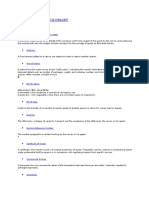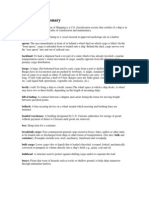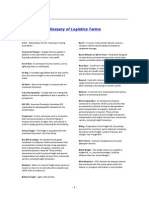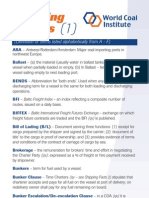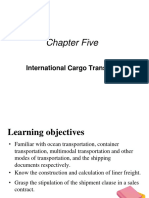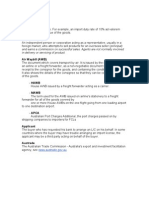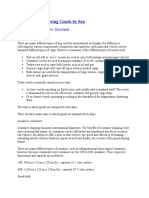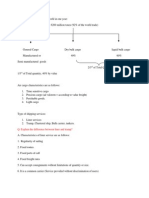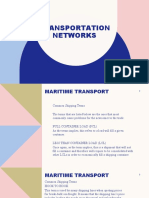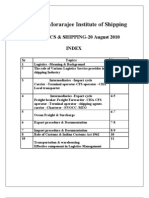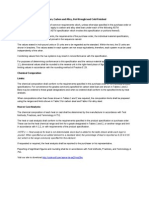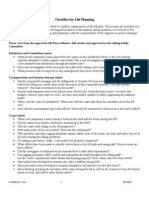Shipping Terms
Shipping Terms
Uploaded by
trungthanhnguyen_83Copyright:
Available Formats
Shipping Terms
Shipping Terms
Uploaded by
trungthanhnguyen_83Copyright
Available Formats
Share this document
Did you find this document useful?
Is this content inappropriate?
Copyright:
Available Formats
Shipping Terms
Shipping Terms
Uploaded by
trungthanhnguyen_83Copyright:
Available Formats
Shipping Terms
A8A Manifest A form issued by a licensed Customs Broker which allows CCRA to monitor in bond shipments as they move through Canada. AMS Automated Manifest System. An application that expedites the clearance of cargo for the subsequent release of containers when imported to U.S.A. through electronic submission of cargo manifests in lieu of bulk paper manifests. Awkward Cargo Cargo of irregular size that can either be containerized (packed in container) or non-containerized (without equipment associated with) during transportation. It requires prior approval on a case-bycase basis before confirmation of booking. Axle Load Maximum load permitted to be carried on each axle of a motor vehicle.
Berth The place beside a pier, quay or wharf where a vessel can be loaded or unloaded. Block Train Railcars grouped in a train by destination so that segments (blocks) can be uncoupled and routed to different destinations as the train moves through various junctions. This eliminates the need to break up a train and sort individual railcars at each junction. Bona fide In good faith. Bonded Carrier
A carrier licensed by U.S. Customs to carry Customs-controlled merchandise between Customs points. Old Dominion is a bonded carrier. Bonded Warehouse A warehouse authorized by Customs for storage of goods on which payment of duties is deferred until the goods are removed. Booking Arrangement with a steamship company for the acceptance and cartage of freight. Bow The front of a vessel. Box Common term for an ocean-going freight container. Broker An individual, partnership or corporation which arranges transportation service for client companies. Break-bulk Cargo Goods shipped loose in the vessel hold and not in a container. Broken Stowage The spare volume of a container or the cargo hold of a vessel where no cargoes are stowed. It is a reflection of the bad stowage of the container or the vessel. Bulk Carriers A vessel carrying dry, liquid, grain, not packaged, bundled or bottled cargo, and is loaded without marks and number or count. Bull Rings Cargo-securing devices mounted in the floor of containers which allow lashing and securing of cargoes.
Bunker Surcharge (BAF, BSC) Bunker Adjustment Factor (BAF), or Bunker Surcharge (BSC) are surcharges assessed by the carrier to freight rates to reflect current cost of bunker. Bunkers Heavy oil used as fuel for ocean vessels.
CAF Currency Adjustment Factor. An ancillary charge on ocean freight to compensate for exchange rate fluctuations. CBM (CM) Cubic metre. CCA Connecting Carrier Agreement. An Agreement of freight rates for connections between feeder ports and the ports of call of vessels. CCRA (Canada Customs and Revenue Agency) Canadian Government Customs Authority. CFS Container Freight Station. A carrier facility where Less Than Container load shipments are consolidated or unloaded. CKD Abbreviation for Cars Knocked Down . Automobile parts and subassemblies manufactured abroad and transported to a designated assembly plant. COD
Collect (cash) on Delivery; Carried on Docket (pricing); Change of Destination. CSA (Customs Self Assessment) A joint Canada/US border initiative aimed at speeding up the customs process on low-risk shipments. C-TPAT (Customs-Trade Partnership Against Terrorism) A joint government and trade community initiative in developing, enhancing and maintaining effective security processes throughout the global supply chain. Cargo Manifest A manifest that lists only cargoes, without freight and charges. Carriers Owned Containers (COC) The containers used for the transportation of cargoes belonging to the property of the carriers. Cells The construction system employed in container vessels which permits containers to be stowed in a vertical line with each container supporting the one above it inside the cargo hold. Cellular Vessel A vessel designed with internal ribbing to permit the support of stacked containers. CFS/CFS A kind of cargo movement by container. Delivered loose at origin point with vanning by carrier, devanned by carrier at destination, and picked up loose at destination. Chassis A wheeled flat-bed constructed to accommodate containers moved over the road. Also termed as Trailers. Closing
The published deadline for export cargoes or containers to be accepted for a sailing of the carrier. CY Closing is applicable to FCLs and CFS Closing is applicable to LCLs. Normally, CFS Closing is around 24 hours ahead of CY Closing, depending of the complexities of export customs clearance formalities at the country. See Late-Come . Consolidated Cargo Cargo containing shipments of two or more shippers, usually shipped by a firm called a consolidator. The consolidator takes advantage of lower FCL rates, and savings are passed on to shippers. Consortium A group of carriers pooling resources, normally container vessels, in a trade lane to maximize their resources efficiently. Container Gross Weight Refer to Gross Weight. Container Load Plan (CLP) A document prepared to show all details of cargoes loaded in a container, e.g. weight (individual and total), measurement, markings, shippers, consignees, the origin and destination of goods, and location of cargo within the container. A Container Load Plan is either prepared by the cargo consolidator or the shipper which ships its cargoes on FCL terms. Container Seal Number A number embossed on high-security seals for closing up containers which will serve identification purposes. Container Type Containers are classified under different types, e.g., dry cargo, reefer, open top, flat-rack, openside, etc. Container Yard (CY or C.Y. )
A facility inside or outside the Container Terminal which accepts laden export containers from shippers or laden import containers for delivery to consignees. Controlled Atmosphere (CA) An atmosphere in which oxygen, carbon dioxide and nitrogen concentrations are regulated, as well as temperature and humidity. Cu. Cubic.A unit of volume meansurement. Cube A measure of volume expressed in cubic feet. Cube the Shipment Measure the total cubic feet of the shipment. Cubic Foot 1,728 cubic inches. Currency Adjustment Factor (CAF) A surcharge percentage applied to freight rates to reflect currency fluctuations between U.S.dollars and other currencies. Customs Bonded Warehouse A public or privately owned warehouse where dutiable goods are stored pending payment of duty or removal under bond. The storage or delivery of goods are under the supervision of customs officers and if the warehouse is privately owned the keeper has to enter into a bond as indemnity in respect of the goods deposited, which may not be delivered without a release from the customs. Custom House Broker An individual or firm licensed to enter and clear goods through Customs. Cut-off Time
Latest possible time the cargo or container may be delivered to the vessel or designated point. See Closing. Cwt. Hundredweight (100 pounds in U.S.A.; 112 pounds in the U.K.). CY/CFS Cargo loaded in a full container by a shipper at origin, delivered to a CFS facility at destination, and then devanned by the carrier for loose pick-up. CY/CY Cargo loaded by the shipper in a full container at origin and delivered to the carrier's terminal at destination for pick-up intact by consignee.
D&H Dangerous and Hazardous. Also see "Dangerous Goods". Dead Space Space in a car, truck, vessel, etc., that is not utilized. Deadweight (D.W.) The number of tons of cargoes, stores and bunker fuel a ship can carry and transport. Also see "Deadweight Tonnage". Deadweight Tonnage (D/W) The number of total weight tons of cargoes, stores and bunker fuel that a vessel can carry and transport. It is the difference between the number of tons of water a vessel displaces "light" and the number of tons it displaces when submerged to the "load line."
Dedicated Unit Train An unit train operated by various railroads for exclusive usage. Demurrage Detention of a freight vehicle or container beyond a stipulated time. Destination Delivery Charge (DDC) A charge assessed by the carrier for the handling of a full container at destinations. The term is more commonly used in the U.S.A. trade. Detention (Demurrage) Charges raised by the carrier or the forwarder for detaining container/trailer at customer premises for a period longer than that provided in the Tariff of the carrier or the forwarder. Detention Charge See "Detention". Devanning The removal of cargo from a container. Also known as unstuffing, unloading or stripping. Differential Rate An amount added or deducted from base rate to make a rate to or from some other point or via another route. Diversion A change made in the route of a shipment in transit. Divert The route of a shipment changed in transit from that shown on the original billing. Used interchangeably with reconsign. Dock
(a) The water alongside a pier or wharf. (b) Loading or unloading platform at an industrial location or carrier terminal. Dock Receipt A document used to acknowledge receipt of cargo or container at a CFS or a CY or a Container Terminal. When delivery of an expert shipment is completed, the dock receipt is surrendered to the vessel operator or the operator's agent in exchange for the ocean or house bill of lading. Domestic Within your own country. Door-to-Door Through transportation of a container and its cargoes from consignor's premises to consignee's premises. Double-deck Load A second tier of cargo placed on top of the first tier. Double Stack Train (DST) Rail or train capable of carrying two 40' containers, one on top of the other. Dray A truck or other equipment designed to haul heavy loads. Drayage Charge made for local hauling by dray or truck; road transportation between the nearest Ocean Port or Railway terminal and the stuffing/destuffing place. Dry Cargo Cargo that does not require temperature control. Dry Dock
An enclosed basin into which a ship is taken for underwater cleaning and repairing. It is fitted with watertight entrance gates which when closed permit the dock to be pumped dry. Dry-Bulk Container A container constructed to carry grain, powder and other free-flowing solids in bulk. Dunnage Lumber or other material used to brace materials in carrier's equipment or containers. Dwell Time It is expressed in terms of number of days that a container changed from one status to another, e.g., from inbound load to empty available to outbound load. The shorter the dwell time, the more efficient the container utilization will be.
Empty Depot A container yard used for the storage of empty containers. En route Along the route of movement. Export Declaration A government document permitting designated goods to be shipped out of the country. FAF Fuel Adjustment Factor. An ancillary charge on ocean freight shipments to account for fluctuations in fuel costs. FAK
Freight All Kind. A system whereby freight is charged per container, irrespective of the nature of the cargoes, and not according to a Tariff. FAS Free Alongside Ship. An INCOTERMS term of sale in which the buyer is responsible for all charges of the transportation of the cargoes after they arrive at the side of the ship. It is not a commonly-used term of sale in international trade today. FAST (Free and Secure Trade) A joint Canada/US border security agreement, of which C-TPAT and PIP are the main initiatives. FBT Full Berth Terms. Indicates that the cost of loading and discharge is included in the steamship rate quoted. Ship owner pays these. FEU Forty foot (40) Equivalent Unit. Commonly describes a 40- foot container. FIO Free In and Out. It is a term used in ship-chartering whereby the owner of the ship is not responsible for any charges incurred in the ports of loading or unloading. FCL/FCL See CY/CY. FCL/LCL See CY/CFS. Feeder Vessel A vessel employed in normally short-sea routes to fetch or carry cargoes and containers to and from ocean-going vessels from the principle port hubs in a region to the minor ports. FEU Forty-foot Equivalent Unit (40' or 2 TEUs) Final Destination
The place where the carrier or the forwarder actually turns over the container or cargo to the consignee of its agent. It is the end of liability of carriers or forwarders. Flash Point A temperature that when certain inflammable cargo reaches will trigger spontaneous ignition. It is an IMCO standard information requirement for dangerous goods. FMC Federal Maritime Commission. US Government Agency responsible for the regulation of all maritime activities. F.O.B Origin F.O.B. Origin means that title and risk pass to the buyer at the moment of the sellers delivery to the carrier. The parties may agree to have title and risk pass at a different time or to allocate freight charges by a written agreement. F.O.B. Destination F.O.B. Destination changes the location where title and risk pass. Under this arrangement, title and risk remain with the seller until they have delivered the freight to the delivery location specified in the contract. Free Storage Period (FSP) A carrier offers a period of time, normally three to five days, at destinations whereby imported containers or cargoes are allowed to be taken delivery by consignees free of any storage charge. After the FSP, there will be an overtime storage charge or demurrage levied by the carriers to the consignee. When bulk shipments are involved, the carriers are prepared to negotiate a longer FSP with the consignees. Freight (a) The price paid to the carrier for the transportation of goods or merchandise by sea or air from one place to another. (b) Freight is also used to denote goods which are in the process of being transported from one place to another. Freight Collect
The freight and charges agreed by the shipper and carrier is payable at destination. Freight Prepaid Freight and charges are required to be paid by a shipper before an original bill of lading is released. Fresh Air Exchange (FAE) The fresh air exchange system in a reefer container which removes harmful gases from reefers carrying sensitive perishable commodities. The fresh air vent is located on the reefer machinery at the end of the container. The fresh air vent is adjustable to accommodate a variety of cargo and chilled load operating conditions. The fresh air vent should be tightly closed when carrying frozen cargo. Full Cellular Ship A ship fitted for container carriage in all available space. The ship is fitted with vertical cells for container placement both below and above deck. No provisions are available for cargo other than containers. Fumigation Treatment of cargoes with a pesticide-active ingredient that is a gas under treatment conditions. It is a process required by many importing countries for the importation of wood and related products. Functional Currency The currency of the primary economic environment of and entity. For ODFL, this is US Dollars.
G.R.I. General Rate Increase. GATT
General Agreement on Tariff and Trade. An international multilateral agreement embodying a code of practice for fair trading in international commerce. Genset (Generator Set) A portable power generator, which converts fuel into electrical power by mechanical means, and from which a reefer draws power. A clip-on generator set is mounted to the front of the refrigeration unit. An underslung generator set is mounted to the chassis upon which the reefer is mounted for handling and transport. The underslung generator set can be either side-mounted or centermounted on the chassis. Gooseneck The front rails of the chassis that raise above the plane of the chassis and engage in the tunnel of a container. Gross Tonnage Applies to vessels, not to cargo. Determined by dividing by 100 the contents, in cubic feet, of the vessel's closed-in spaces. A vessel ton is 100 cubic feet. Gross Weight Entire weight of goods, packaging and container, ready for shipment. Hatch The opening in the deck of a vessel which gives access to the cargo hold. Haulier The participating carrier responsible for drayage of containers. Heavy Lift Articles too heavy to be lifted by a ship's tackle. Heavy-Lift Charge A charge made for lifting articles too heavy to be lifted by a ship's tackle. High Cube (HC or HQ)
Any container which exceeds 8 feet 6 inches (102 inches) in height, usually 9 feet 6 inches. Hold It is the part of the ship below decks where the cargo is stored. House Bill of Lading (HB/L) Bill of lading issued by a forwarder or an NVOCC operator. House-to-House (H/H) See CY/CY. House-to-Pier (H/P) See CY/CFS. Hull The body of a vessel exclusive of masts, yards, sails, rigging, machinery and equipment. Hull Underwriter The person with whom the ship hull, machinery apparel, and tackle is insured. I.M.C.O. International Maritime Consultative Organization. A forum in which most major maritime nations participate and through which recommendations for the carriage of dangerous goods, bulk commodities and maritime regulations become internationally acceptable. IPI Interior Points Intermodal. A term used by ocean carriers to describe door-to-door delivery service. I.T. In Transit Document (Form 7512) issued by a licensed Customs Broker which allows U.S. Customs to monitor in bond shipments moving in the U.S. IMDG Code
International Maritime Dangerous Goods Code. The IMCO recommendations for the carriage of dangerous goods by sea. Import Permit Usually required for items that might affect the public health, morals, animal life, vegetation, etc. Examples include foodstuffs, feedstuffs, pharmaceuticals (human and veterinary), medical equipment, seeds, plants and various written material (including tapes, cassettes, movies, TV tapes or TV movies). In some countries an import permit is the same as an import licence. In Bond A term, which indicates that an imported shipment was not cleared by Customs at the border, and is moving under a surety bond. Inbound Inward bound. Direction of vessel or cargo going to port of discharge or final destination. Inland Clearance Depot A CFS with Customs Clearance Facilities. Insulated Container A container insulated on the walls, roof, floor and doors, to reduce the effect of external temperatures on the cargo. Insulated Tank Container The frame of a container constructed to hold one or more thermally insulated tanks for liquids. Interchange Transfer of a container from one party to another. Intermodal Pertaining to transportation involving more than one form of carrier: truck, ship and rail. Intermodal Transport
Moving ocean freight containers by various transportation modes. The fact that the containers are of the same size and have common handling characteristics permits them to be transferred from truck to railroad to air carrier to ocean carrier.
Keel The main center-line structural member, running fore and aft along the bottom of a ship, sometimes referred to as the backbone. Knot A unit of speed. The term "knot" means velocity in nautical miles per hour whether of a vessel or current. One nautical mile is roughly equivalent to 1.15 statute miles or 1.85 kilometers L.C.L. Less than Container Load. Cargo in quantity less than required for the application of a container load rate. LCL/FCL See CFS/CY. LCL/LCL See CFS/CFS. Lashing Support for cargoes inside a container or a cargo hold to ensure that they are secured and will not be subject to rolling during the voyage from origin to destination. Late-Come It is a term used in the liner industry when extensions are being given to the shippers against the official CY or CFS Closing date and time which carriers publish to the trade.
Letter of Indemnity Guarantee from the shipper or consignee to indemnify carriers or forwarders for costs and/or loss, if any, in order to obtain favourable action by carriers or forwarders. It is customary practice for carries and forwarders to demand letters of indemnity from consignees for taking delivery of cargoes without surrendering bill of lading which has been delayed or is lost. Lien A legal claim upon goods for the satisfaction of some debt or duty. Lift-On/Lift-Off (LO-LO) A container ship onto which containers are lifted by crane. Lighter An open or covered barge towed by a tugboat and used mainly in harbours and inland waterways. Lighterage Refers to the carriage of cargoes by lighter and the charge assessed therefore. Liner Vessel plying a regular trade/defined route against a published sailing schedule. Liner Terms Freight includes the cost of loading onto and discharging from the vessel. Lloyds' Registry An organization maintained for the surveying and classing of ships so that insurance underwriters and others may know the quality and condition of the vessels offered for insurance or employment. Load Factor Percent of loaded containers against total capacity of vessel or allocation. Locking Bar Device that secures container doors at top and bottom.
Long Ton 2,240 pounds. Longshoreman Workers employed in the terminals or quays to load and unload ships. They are also known as Stevedores. Loop A particular service of any Consortium or Carrier among various ports of calls, with the objective of creating a niche in the market for the first port of discharge. Loose Without packing. Low-Bed A trailer or semi-trailer with no sides and with the floor of the unit close to the ground.
Manifest A document that lists in detail all the bills of lading issued by a vessel or its agent or master, i.e., a detailed summary of the total cargoes or containers loaded in a vessel. Used principally for customs purposes. It is also called summary of Bills of Lading. Maquiladoras (makiladoras) Duty-free (for U. S. import) manufacturing plants located in Mexico. Marine Insurance Broadly, insurance covering loss or damage of goods at sea. Marine insurance typically compensates the owner of merchandise for losses sustained from fire, shipwreck, piracy and various other causes but excludes losses that can be legally recovered. Maritime
Business pertaining to commerce or navigation transacted upon the sea or in seaports in such matters as the court of admiralty has jurisdiction over. Marks and Numbers Marks and Numbers placed on packages for export for identification purposes; generally a triangle, square, circle, diamond, or cross with letters and/or numbers and port discharge. They are of important use before containerization. Master Lease Master lease is one form of a short-term lease, which refers to the leasing of the containers by carriers from those leasing companies. Master Lease Leasing Cost Master lease leasing cost includes container rental, depot lift-on/lift-off charge, on/off hire drayage, drop-off charge and offhire repair cost, etc. Due to off-hire quota limitation, the average on-hire period is around 73 days for 20'GP, 40'GP and 102 days for 40'HQ. Mate's Receipt A receipt signed by a mate of the vessel, acknowledging receipt of cargo by the vessel. The individual in possession of the mate's receipt is entitled to the bill of lading, which in due course is issued in exchange for that receipt. Maximum Payload Maximum cargo that can be loaded into a container either by weight or volume. Maximum Rate The highest freight rate permitted by a regulatory body to apply between points. Measurement Ton 1 cubic metre. One of the alternative bases of Freight Tariff. Microbridge
A landbridge movement in which cargo originating/destined to an inland point is railed or trucked to/from the water port for a shipment to/from a foreign country. The carrier is responsible for cargo and costs from origin to destination. Also known as I.P.I. or Through Service. Mini Landbridge (MLB) An intermodal system for transporting containers from/to a foreign country by water to/from a U.S. ocean port other than the arrival port by rail at through rates and documents. Mini-Bridge Cargo moving from/to an inland destination on one bill of lading from/to a foreign port through two U.S. ports. Minimum Charge The lowest charge that can be assessed to transport a shipment. NAFTANorth American Free Trade Agreement The joint Canada, Mexico and United States treaty to reduce tariffs and trade barriers to promote cross-border economic activity. Net Tonnage A vessel's gross tonnage minus deductions of space occupied by accommodation for crew, by machinery, for navigation, by the engine room and fuel. A vessel's net tonnage expresses the space available for passengers and cargoes. Net Weight Weight of the goods alone without any immediate wrappings, e.g., the weight of the contents of a tin can without the weight of the can. Also called actual net weight. O.C.P. rate Overland Common Point rates which are generally lower than local tariff rates. They were established by the U.S. West Coast steamship companies in conjunction with railroads serving the western U.S. ports so that cargo originating or destined to the American Midwest and East would
be competitive with all-water rates via the U.S. Atlantic and Gulf ports. O.C.P. rates are also applicable to eastern Canada. O.R.C. Origin Receiving Charge. A Terminal Handling Charge levied at ports of loading. Ocean Route The all-water transportation portion of a route. One-Way lease The lease of containers that covers the outbound voyage only, after which the container is returned to the lease holder at or near destination agreed. Open-Top Container A container fitted with a solid removable roof or with a tarpaulin roof that can be loaded or unloaded from the top. Outbound Outward bound. Direction of vessel or cargo going out from port of loading or point/place of receipt. Overheight Cargo Cargoes which exceed 9-1/2 ft. in height. They have to be stowed normally in an open-top container.
PAPSPre-Arrival Processing System An electronic system that allows U.S. Customs to review and pre-release shipments for import into the U.S. PARS/INPARSPre-Arrival Review System
Available both at the border and inland (INPARS). An electronic system that allows CCRA to review and pre-release shipments for import into Canada. P.O.D. Port of Discharge. The port at which cargoes or containers are discharged from vessel. When transshipment is needed, there can be a number of PODs during the course of shipment until it reaches the final POD. P.O.L. Port of Loading. The port at which cargoes or containers are loaded onto vessels. PIPPartners in Protection A CCRA initiative designed to enlist the cooperation of private industry in efforts to enhance border security and increase awareness of customs compliance issues. Pallet A platform (usually two-deck), with or without sides, on which a number of packages or pieces may be loaded to facilitate handling by a lift-truck. Participating Carrier (Tariff) A carrier that is a party, under concurrence, to a tariff issued by another transportation line or by a tariff's publishing agent. Per Diem Per day. Perishable Cargo Cargo subject to decay or deterioration, normally fresh food and vegetables, etc. Pier-to-House (P/H) See CFS/CY. Pier-to-Pier (P/P)
See CFS/CFS. Pilot A person whose office or occupation is to steer ships, particularly along a coast or into and out of a harbour. Place of Acceptance See Place of Receipt. Place of Delivery See Final Destination. Place of Receipt (P.O.R.) Location where cargo enters the care and custody of the carrier. Same as Place of Acceptance. It is the starting port of carriers liability upon receipt of cargoes from shippers. Port (a) Harbour with piers or dock. (b) Left side of a ship when facing the bow. (c) Opening in a ship's side for handling freight. Port of Arrival Location where imported merchandise is off loaded from the importing aircraft or vessel. Port of Call A port where a vessel discharges or receives traffic. Port of Entry A port where cargoes and containers destined elsewhere are actually discharged from a vessel. Port of Loading (POL) A port where cargoes or containers are loaded onto a vessel. Quarantine
The period during which a vessel is detained in isolation until free from any contagious disease among the passengers or crew. The word is now applied to the sanitary regulations which are the modern substitute for quarantine. During the quarantine period, the Q flag is hoisted. Quarantine Buoy One of the yellow buoys at the entrance of a harbour indicating the place where vessels must anchor for the exercise of quarantine regulations. Quarantine Declaration A document signed by the captain and the ships doctor before the port health officer when a ship arrives at the quarantine station. It gives the name of the ship, tonnage, number of crew, first port of voyage and date of sailing, intermediate ports called at, number of passengers for the port at which the vessel is arriving, number of transit passengers, cases of infectious diseases during voyage, deaths, nature of cargo, name of agents. The port health officer then proceeds with the medical inspection of passengers and crew. Also called Entry Declaration. Quarantine Dues A charge against all vessels entering a harbour to provide for the maintenance of medical control service. Also called Quarantine Fees. Quarantine Flag A yellow flag used as a sanitary signal. It is displayed by all vessels entering a harbour; also when a contagious or infectious disease exists on board or when the vessel has been placed in quarantine. Quarantine Harbour A place where vessels in quarantine are stationed when arriving from contaminated ports. Quarantine Station A medical control centre located in an isolated spot ashore where patients with contagious diseases from vessel in quarantine are taken. It is also used for passengers and crews of vessel arriving from suspected ports while fumigation or any other disinfection is carried out on board ship.
RNSRelease Notification System The electronic notification system that provides customers, customs agencies and customers broker representatives with proactive notification of shipment acceptance, review and release. Received-for-Shipment Bills of Lading A term used in contrast to shipped bill of lading or on-board bill of lading. This kind of bill of lading is normally issued to acknowledge receipt of shipment before cargo loading or before official original bill of lading is issued. Nowadays, not many shippers ask for this kind of bill of lading. Reefer In the industry, it is the generic name for a temperature-controlled container. The containers, which are insulated, are specially designed to allow temperature controlled air circulation within the container. A refrigeration plant is built into the rear of the container. Relative Humidity % The ratio of the actual amount of water vapour in the air to the maximum it can hold at a given temperature, multiplied by 100. Relay To transfer cargoes from one ship to another of the same ownership. Release Note A receipt signed by a customer acknowledging the delivery of cargoes. Revenue Ton (R/T) The greater weight or measurement of cargoes where 1 ton is either 1000 kilos or 1 cubic metre (for metric system). Also known as Bill of Lading Ton or Freight Ton. It is used to calculate freight charge. Roll-On/Roll-Off (Ro/Ro)
A feature designed in a specially constructed vessel in both the loading and discharging ports. Route The plan of movements of a vessel from the first port of call to her final destination. SED Shippers Export Declaration. A form, which is often, required prior to exporting a product. Salvage The property which has been recovered from a wrecked vessel, or the recovery of the ship herself. Salvage Clause A marine insurance policy clause which states the proportion of salvage charges for which underwriters are liable. Salvage Lien A maritime lien which exists when a ship or goods come into the possession of one who preserves them from the perils at sea. All salvage services carry with them a maritime lien on the items saved. Salvage Value The value on which salvage is awarded. It generally means the value of ship and cargoes when they have been brought to a place of safety by the salvors. Seal A metal strip and lead fastener used for locking containers, freight cars or truck doors. Seals are numbered for record and security purposes. Seal Record A record of the number, condition and marks of identification on seals made at various times and places, referring to the movement of the container between origin and destination. Service Contract
The Shipping Act of 1984 of U.S.A. allows a contract between a shipper (or a shippers' association) and an ocean common carrier, NVOCC operator or a Shipping Conference in which the shipper makes a commitment to provide a certain minimum quantity of cargo or freight revenue over a fixed time period, and the ocean common carrier, NVOCC operator or conference commits to a certain rate or rate schedule as well as a defined service level (such as assured space, transit time, port rotation or similar service features). The contract may also specify provisions in the event of nonperformance on the part of either party. Ship Chandler An individual or company selling equipment and supplies for ships. Ship Planning A function in the operations of container vessels where containers have to be planned for loading onto vessels, taking into consideration the size and weight of containers, transshipment and discharging port rotation, types of cargoes, etc. The officer responsible for such a function is called a Ship Planner . Shipped Bill of Lading A bill of lading issued only after the cargoes have actually been shipped on board the vessel, as distinguished from the Received-for-Shipment bill of lading. Also see On- board Bill of Lading. Shipped on-board Endorsement on a bill of lading confirming loading of cargoes or containers on a vessel. Shipper The person for whom the owners of a ship agree to carry goods to a specified destination and at a specified price. Also called Consignor. The conditions under which the transportation is effected are stipulated in the bill of lading. Shipper Owned Container (SOC) The container used for cargo shipment is owned by the shipper. Shipper's Load and Count
Shipments loaded and sealed by shippers and not checked or verified by the carriers or forwarders. Neither the carriers nor the forwarders will assume any liability for shortages of cargoes as long as the container seal remains intact at the time of devanning. Shipping Order A set of documents of carriers or forwarders which allows the shippers to book shipping space with them. There are a number of copies with the same form and contents but with different names such as the 1st copy is called Shipping Order and the remainders are called Shipping Order Copy or Dock Receipt for different purposes such as space control, surveyor and sworn measurer, confirmation of receipt of cargoes/containers, etc. As EDI is more popular nowadays and used by both the shipper and Customs, hardcopy Shipping Order is no longer widely used. Shipside Delivery A special cargo handling instruction for cargoes to be delivered rightaway at shipside after discharge. Shut-out Cargoes or containers which are not loaded on-board the intended vessel in line with the Shipping Order confirmed with the carrier. Slot Space on board a vessel occupied by a container. Stability The force that holds a vessel upright or returns it to upright if keeled over. Weights on the lower hold increase stability. A vessel is stiff if it has high stability, tender if it has low stability. Stack Car An articulated five-platform railcar that allows containers to be double-stacked. A stack car holds ten 40-foot equivalent units. Standard International Trade Classification (SITC)
A standard numerical code used by the United Nations to classify commodities used in international trade. Starboard The right-hand side of a ship when facing the bow. Said to Contain (STC) A standard clause used to protect carrier, NVOCC operators or forwarders when cargoes are stuffed into the container by shippers, their agents or other third parties. See also Shippers Load and Count. Stern The end of a vessel. Opposite of bow. Stevedore See Longshoreman. Store-Door Delivery (STOR/DOR) Delivery of goods to consignee's place of business or warehouse by motor vehicle. Refers to a complete package of delivery services performed by a carrier from origin to final consumption point, whether that be a retail, wholesale or other final distribution facility. Store-Door PickUp Picking up an empty container from a carrier, delivering it to a merchant and returning the laden container; the portion of store-door pick up performed by the carrier's trucker. Stowage A marine term referring to loading freight into the ships' holds. Straight Bill of Lading A term for a non negotiable bill of lading. Stripping
The unloading of a container. Stuffing The loading of a container. Supply Air Cooled or warmed air leaving the evaporator delivered to the interior of the container. Supply air is sometimes called delivery-air. Surcharge An extra or additional charge.
TEU Twenty-Foot (20) Equivalent Unit. Commonly describes a 20-foot container. TVA Time Volume Agreement. A contract between a carrier and shipper specifying the movement of a number of containers over time. T-floor Interior floor in a reefer, so named because of the longitudinal T-shaped rails which support the cargo and form a plenum for air flow beneath the cargo. Tail The rear of a container. Tank Container A specially constructed container for transporting liquids and gases in bulk.
Tare Weight The weight of packing material or, in carload shipments, the weight of the empty freight car, or the weight of a container. Tariff A publication setting forth the charges, rates and rules of transportation companies. Terminal An assigned area in which containers are prepared for loading into a vessel or are stacked immediately after discharge from the vessel. TEU Twenty-foot Equivalent Unit (20") . Terminal Handling Charge (THC) A charge of carriers for recovering the costs of handling FCLs at container terminals at origin or destination. Through Rate The total rate from the point of origin to final destination. Through Service (Thru Service) A combination of transportation by sea and land (Thru Service) services to/from the point of origin to final destination. Time Charter A charter party hiring a vessel for a specified period of time in which the shipowner provides the vessel, bunkers and crew while the charterer supplies the cargo. Tonnage Generally refers to freight handled. Towage
The charge made for towing a vessel. Tramp A freighter vessel that does not run in any regular trade lane but takes cargo wherever the shippers desire. Tranship To transfer goods from one transportation line (trade lane) to another, or from one ship to another. Transhipment Hub A port which is employed by a carrier for transshipping its carriers from one transportation line ( trade lane ) to another. Transit Cargo Goods onboard which upon their arrival at a certain port are not to be discharged at that port. Transit Port A port where cargoes received are merely en route and from which they have to be transferred and dispatched to their ultimate destination by coasters, barge and so on. Also called Transshipment Port. Terminal Receiving Charge (TRC) A charge assessed by the terminal for cargoes being delivered for export.
UNCTAD United Nations Conference on Trade and Development. UNCTAD MMO UNCTAD Multi Modal Transport Convention. Underwriter
In marine insurance, one who subscribes his name to the policy indicating his acceptance of the liability mentioned therein, in consideration for which he receives by way of a premium. Unit Load Packages loaded on a pallet, in a crate or any other way that enables them to be handled at one time as a unit. Unit Train A train of a specified number of railcars, perhaps 100, wherein they remain in a unit for a designated destination or until a change in routing is made. USDA United States Department of Agriculture. Vanning A term sometimes used for stowing cargo in a container. Ventilated Container A container designed with openings in the side and/or end walls to permit the ingress of outside air when the doors are closed. Vessel's Manifest Statement of a vessel's cargoes or containers (revenue, consignee, marks, etc.). Voyage Charter A charter party hiring a vessel for a particular voyage in which the shipowner provides the vessel, bunkers and crew whilst the charterer supplies the cargoes. Voyage Direction The sector of a round trip voyage normally denoted by the direction of the sailing. Voyage Number The numeric identification of a trip undertaken by a vessel on a fixed trade lane.
Warehouse A place for the reception and storage of cargoes. Waybill (WB) A document prepared by a transportation line at the point of a shipment; shows the point of the origin, destination, route, consignor, consignee, description of shipment and amount charged for the transportation service. A waybill is forwarded with the shipment or sent by mail to the agent at the transfer point or waybill destination. Unlike a bill of lading, a waybill is not a document of title. Weight Cargo A cargo on which the transportation charge is assessed on the basis of weight. Wharfage A charge assessed by a pier or dock owner against freight handled over the pier or dock or against a steamship company using the pier or dock.
You might also like
- How To Prepare A Process Design BasisDocument8 pagesHow To Prepare A Process Design BasisChijioke Obi100% (1)
- The Shipbroker’s Working Knowledge: Dry Cargo Chartering in PracticeFrom EverandThe Shipbroker’s Working Knowledge: Dry Cargo Chartering in PracticeRating: 5 out of 5 stars5/5 (1)
- 2018-11-01 Bake From Scratch PDFDocument116 pages2018-11-01 Bake From Scratch PDFLia Vágvölgyi100% (4)
- International Shipping TermsDocument42 pagesInternational Shipping TermsPierre Bouvier100% (1)
- Shipping VocabularyDocument11 pagesShipping VocabularyNoe S. Soria100% (1)
- Shipping CourseDocument132 pagesShipping Coursevkrm14100% (1)
- Container TerminalDocument13 pagesContainer TerminalSameer Jena Sam50% (2)
- Shipping Terms PDFDocument18 pagesShipping Terms PDFJanmejaya MishraNo ratings yet
- International Logistics GlossaryDocument12 pagesInternational Logistics GlossaryDiego100% (1)
- Shipping GlossaryDocument38 pagesShipping GlossaryaechiNo ratings yet
- Freight Shipping Glossary: Air Waybill (Abbreviation: AWB)Document6 pagesFreight Shipping Glossary: Air Waybill (Abbreviation: AWB)csmcargoNo ratings yet
- Glossary of Shipping TermsDocument38 pagesGlossary of Shipping TermsPrashant SinghNo ratings yet
- Shipping DictionaryDocument11 pagesShipping DictionaryChamor Gerem100% (1)
- Shipping TermsDocument12 pagesShipping TermsHugo PerniaNo ratings yet
- Terms MeaningsDocument3 pagesTerms Meaningssrik_tryNo ratings yet
- Safmarine GlossaryDocument66 pagesSafmarine GlossaryThavasi NadarNo ratings yet
- Glossary of Maritime TermsDocument1 pageGlossary of Maritime TermsChristian ChavezNo ratings yet
- Maritime DictionaryDocument10 pagesMaritime DictionaryvjmarinerNo ratings yet
- Maritime TransportationDocument37 pagesMaritime Transportationbehzad parsiNo ratings yet
- Freight TerminologyDocument2 pagesFreight Terminologymoon_mohiNo ratings yet
- Liner TradeDocument4 pagesLiner Tradesachin vermaNo ratings yet
- AAA Shipping AbbreviationsDocument8 pagesAAA Shipping AbbreviationsBadar NabviNo ratings yet
- Glosario Ingles LogisticaDocument18 pagesGlosario Ingles LogisticaCarlos WcNo ratings yet
- Glosario OOCL 19Document21 pagesGlosario OOCL 19tilo0230No ratings yet
- Glossary of Logistics TermsDocument10 pagesGlossary of Logistics TermsChouk MetaNo ratings yet
- Shippingfacts1 (04 06 2009)Document2 pagesShippingfacts1 (04 06 2009)sosriantoNo ratings yet
- Chapter5 Introductional Cargo TransportationDocument51 pagesChapter5 Introductional Cargo TransportationBoxing GloveNo ratings yet
- Shipping TermsDocument9 pagesShipping TermsLeakhanakNguonNo ratings yet
- International Commercial TermsDocument6 pagesInternational Commercial Termsarif UrmiNo ratings yet
- Shipping GlosseryDocument15 pagesShipping GlosseryroutraykhushbooNo ratings yet
- Chartering Terms DefinitionDocument29 pagesChartering Terms DefinitionRam StonedNo ratings yet
- A Guide To Moving Goods by SeaDocument22 pagesA Guide To Moving Goods by SeaSabir S. GhaffarNo ratings yet
- Shipping AbbreviationsDocument16 pagesShipping AbbreviationsHady SalahNo ratings yet
- Logistics TerminologyDocument10 pagesLogistics Terminologyquanghuy061285No ratings yet
- Bulk Cargo: ShipbrokersDocument4 pagesBulk Cargo: ShipbrokersVaishali ShuklaNo ratings yet
- Freight: Capt. Swaminathan RajagopalanDocument25 pagesFreight: Capt. Swaminathan RajagopalanThavasi Nadar100% (2)
- Liner ShippingDocument8 pagesLiner ShippingMayank BhattNo ratings yet
- Abrevieri CharterDocument16 pagesAbrevieri CharterBadea Ionel AndreiNo ratings yet
- David IL 4e Chapter11Document21 pagesDavid IL 4e Chapter11Klint Allen Amblon MariñasNo ratings yet
- Arrastre and Port Operations TerminologiesDocument36 pagesArrastre and Port Operations TerminologiesAceNo ratings yet
- 4.5 Contaienr TransportDocument15 pages4.5 Contaienr Transport185Y038 AKSHATA SAWANTNo ratings yet
- Unit 07 Hunnain 18 35Document18 pagesUnit 07 Hunnain 18 35Hunain PalobaNo ratings yet
- Maersk GlossaryDocument28 pagesMaersk GlossaryPrashant BhardwajNo ratings yet
- What Is Ocean Freight?Document11 pagesWhat Is Ocean Freight?Parth ShashooNo ratings yet
- Cargo and Packaging 1Document31 pagesCargo and Packaging 1Nureni SusilowatiNo ratings yet
- Terms Commonly Used in Cargo HandlingDocument4 pagesTerms Commonly Used in Cargo HandlingKrissa Sustal100% (1)
- Stowage Principles & Stowage PlanningDocument14 pagesStowage Principles & Stowage Planningmoaid013No ratings yet
- Voyage Charter FDocument12 pagesVoyage Charter FKwalar KingNo ratings yet
- Understanding Port Operations and Logistics - Supply Chain FlowDocument11 pagesUnderstanding Port Operations and Logistics - Supply Chain FlowPiney MartinNo ratings yet
- Chartering AbbreviationsDocument12 pagesChartering Abbreviationsmaxred maxredNo ratings yet
- The Secret To Understanding Sea Freight RatesDocument23 pagesThe Secret To Understanding Sea Freight Rateshumberto arroyoNo ratings yet
- Container Shipment-Cost Structure: S.L.GanapathiDocument16 pagesContainer Shipment-Cost Structure: S.L.GanapathiAnkur MakhijaNo ratings yet
- Transportation Management Final Class 01.14Document18 pagesTransportation Management Final Class 01.14ElmerNo ratings yet
- 0-VNS - ISO Tank TransportDocument56 pages0-VNS - ISO Tank Transportvns081104No ratings yet
- Ship Chartering TermsDocument16 pagesShip Chartering TermsAli Osman YaşarNo ratings yet
- Logistics & Shipping (Basics)Document12 pagesLogistics & Shipping (Basics)Joju JohnyNo ratings yet
- Understanding International Transport1Document5 pagesUnderstanding International Transport1Narsingh SharmaNo ratings yet
- LSS Glosary 2020Document24 pagesLSS Glosary 2020Julian Santiago Corredor FrasserNo ratings yet
- 1-Glossary of Maritime WordsDocument15 pages1-Glossary of Maritime Wordscptmehmetkaptan100% (1)
- Glossary of Shipping TermsDocument10 pagesGlossary of Shipping Termsmoon_mohiNo ratings yet
- ALLISION The ST-WPS OfficeDocument5 pagesALLISION The ST-WPS OfficemahaqureshivogueNo ratings yet
- Shipping Practice - With a Consideration of the Law Relating TheretoFrom EverandShipping Practice - With a Consideration of the Law Relating TheretoNo ratings yet
- Miller-Struttmann Et Al.2015. Functional Mismatch in A Bumble Bee Pollination Mutualism Under Climate ChangeDocument5 pagesMiller-Struttmann Et Al.2015. Functional Mismatch in A Bumble Bee Pollination Mutualism Under Climate ChangeJohan NavarroNo ratings yet
- ASME IIA SA29 SA29M Steel Bars, Carbon and Alloy, Hot-Wrought and Cold-FinishedDocument1 pageASME IIA SA29 SA29M Steel Bars, Carbon and Alloy, Hot-Wrought and Cold-FinishedAmanda Ariesta ApriliaNo ratings yet
- Colour Code According To DIN VDE 0293: 1) Multicore Flexible CablesDocument1 pageColour Code According To DIN VDE 0293: 1) Multicore Flexible CablesrocketvtNo ratings yet
- ID9464Document11 pagesID9464banabanolcreator39No ratings yet
- Iso 8686 1 2012 en PDFDocument11 pagesIso 8686 1 2012 en PDFMehdi MabroukNo ratings yet
- Lift Plan ChecklistDocument5 pagesLift Plan ChecklistAdnan Ali ChaudhryNo ratings yet
- 3 Water ResourcesDocument11 pages3 Water Resourcessmak11No ratings yet
- List F CompaniesDocument84 pagesList F Companiesggangan.zmgNo ratings yet
- Calculation - Floating Cover #2Document9 pagesCalculation - Floating Cover #2calinvasco190670No ratings yet
- PCI Pulley Selection Guide 2023Document37 pagesPCI Pulley Selection Guide 2023Sebastián Silva ReyNo ratings yet
- United States Led Display Screen Market by Manufacturers States Type and Application Forecast To 2022 PDFDocument10 pagesUnited States Led Display Screen Market by Manufacturers States Type and Application Forecast To 2022 PDFRohan MeharaNo ratings yet
- Brain Storming AverageDocument3 pagesBrain Storming AverageMahesh ChavanNo ratings yet
- XIth PhysicsDocument48 pagesXIth PhysicsTanishq GangatkarNo ratings yet
- AlcoholsDocument8 pagesAlcoholsljbnoibnoibnNo ratings yet
- Work Order For Gear Box and CondenserDocument3 pagesWork Order For Gear Box and CondenserTejas ShahNo ratings yet
- ARUN (NEW) 1 - 18 Sep 17 - 16 06 10Document4 pagesARUN (NEW) 1 - 18 Sep 17 - 16 06 10K Vinoth ShivanNo ratings yet
- J P Sir HORTI GMVDocument77 pagesJ P Sir HORTI GMVNiveditaNo ratings yet
- Jumbo TailDocument2 pagesJumbo TailVaishno JhaNo ratings yet
- Model Question PaperPV 1Document2 pagesModel Question PaperPV 1Me NasyrNo ratings yet
- Operation and Monitoring of A Solar Power PlantDocument39 pagesOperation and Monitoring of A Solar Power PlantDebashis TaraiNo ratings yet
- RPH ReportDocument48 pagesRPH ReportMaricel RaguindinNo ratings yet
- The Nature of The Economic ProblemDocument3 pagesThe Nature of The Economic Problemrathreyapurapu464No ratings yet
- VBACDocument12 pagesVBACSakinah Roslan100% (1)
- Lord Hath Spoken, The, Number 2, by B. H. RobertsDocument8 pagesLord Hath Spoken, The, Number 2, by B. H. RobertsMiguel Angel Arizola ZavalaNo ratings yet
- The LaTeX Mathematics CompanionDocument78 pagesThe LaTeX Mathematics CompanionNéstor Valles-VillarrealNo ratings yet
- Daily ReportDocument14 pagesDaily ReportKrishna GuptaNo ratings yet
- Banana CaseDocument14 pagesBanana Casenandini_mba4870No ratings yet
- Leak Survey HandbookDocument11 pagesLeak Survey HandbookebbasinghNo ratings yet










